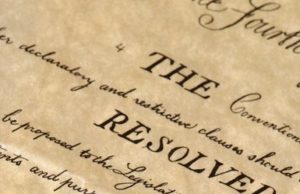Table of Contents

The Constitution of the United States is a remarkable document that has proven time and again to be one of the most significant in the history of mankind. Among its many provisions, the 20th Amendment has a special place in the hearts of Americans because it defines when the various elected officials are to take their respective offices, and when their terms of office expire.
The 20th Amendment was drafted and ratified in the early 20th century as part of a broader movement toward government reform that empowered voters and shortened lame-duck legislative sessions. The amendment is a reflection of the country’s desire to move beyond the old, outmoded ways of governing and to embrace a more modern, forward-thinking approach.
What is the 20th Amendment?
The 20th Amendment to the US Constitution is commonly known as the “Lame Duck Amendment.” The term ‘lame duck’ refers to the elected officials who have failed to be re-elected yet remain in office until the end of their term. This amendment was ratified on January 23, 1933, and started the new meaning from January 20, 1937.
The amendment was an attempt to solve problems associated with the long period of time between the election of a new president and the inauguration of that president, which could last up to four months. The amendment ultimately reduced the time between the election and the swearing-in ceremony, thereby ensuring a more efficient transition of power.
The amendment also included provisions dealing with the timing of congressional elections and the process of filling vacant vice-presidential positions. It established that the vice president-elect would become president in the event of a president-elect’s de-legitimization. Moreover, it clarified the presidential succession procedure of the death of a sitting President before his/her inaugurations.
Direct quotations from the 20th Amendment
Here are the direct quotations from the 20th Amendment to the Constitution of the United States.
‘Section 1. The terms of the President and Vice President shall end at noon on the 20th day of January, and the terms of Senators and Representatives at noon on the 3d day of January, of the years in which such terms would have ended if this article had not been ratified; and the terms of their successors shall then begin.’
‘Section 2. The Congress shall assemble at least once in every year, and such meeting shall begin at noon on the 3d day of January unless they shall by law appoint a different day.’
‘Section 3. If, at the time fixed for the beginning of the term of the President, the President-elect shall have died, the Vice President-elect shall become President. If a President shall not have been chosen before the time fixed for the beginning of his term, or if the President-elect shall have failed to qualify, then the Vice President-elect shall act as President until a President shall have qualified; and the Congress may by law provide for the case wherein neither a President-elect nor a Vice President-elect shall have qualified, declaring who shall then act as President, or the manner in which one who is to act shall be selected, and such person shall act accordingly until a President or Vice President shall have qualified.’
‘Section 4. The Congress may by law provide for the case of the death of any of the persons from whom the House of Representatives may choose a President whenever the right of choice shall have devolved upon them, and for the case of the death of any of the persons from whom the Senate may choose a Vice President whenever the right of choice shall have devolved upon them.’
Understanding the meaning of the 20th Amendment
The 20th Amendment sections provide clarity on the length of terms for elected officials, the time of convening of the legislative session, the issue of succession, and the powers of Congress in such circumstances.
The first section deals with the terms of elected officials – the President, Vice President, Representatives, and Senators. It determines the new term of their successors and makes it clear that their term will end on January 20 after the election year. Similarly, in the case of the legislative branch, their terms will end on January 3 after the election year. The second section states that Congress needs to meet at least once a year. It specified that the meet should be on January 3 unless a later date is specified in law.
The third section deals with the transition process and succession. It states that, in case the President-elect is unable to assume office, the Vice President-elect becomes President. If the Presidential-elect dies before the inauguration date, the Vice President-elect should assume the position of President. If both the President-elect and Vice President-elect die before the inauguration, then the Congress shall establish a new method of selecting the President.
Section four deals with the vacancy of the presidential or Vice presidential position before the end of their term. It grants Congress the power to establish a new mode of selecting the President or Vice President, making it easier to fill any vacancy that may occur on either position.
One significant change brought on by the 20th Amendment was the length of time between election and inauguration. Before the amendment, that length could potentially last up to four months. Unnecessary and excessive delays resulted in a quagmire for the country, and the transition process was sometimes slow and inefficient. The amendment ensured that the transfer of power would happen faster, with the new President assuming office only seventy-two days after the election.
How the amendment has influenced the United States
The 20th Amendment to the Constitution was a significant change the U.S. government system. Its implications touched all corners of the country. The amendment had a considerable impact on various state governments and the country as a whole.
The new changes applied in each state and their citizens reacted in different ways to ensure the successful application of the new amendment. The states’ individual election regulations had to be amended, and primary and general election dates altered to allow for the appropriate amount of time for transition between old and newly elected officials.
The amendment has a considerable effect on the country as a whole, and it continues to impact it positively to this day. The 20th Amendment has ensured the peaceful transfer of power during times of political and social instability. The smooth transition of power remains a pillar of the American democracy, and the principles enshrined in the 20th Amendment support that.
How the 20th Amendment has influenced American history
The 20th Amendment is an indispensable change that has since influenced American history in many ways. It has ensured that the US government’s transition of power remains smooth despite any unprecedented events such as the death of a President or Vice President. The Amendment took care of certain factors negatively affecting American governance.
Before the amendment, crooked politicians in office would remain in power for an average of almost four months as there was no constitution to checkmate the situation. The four unexpected months led to several decisive and corrupt actions that negatively impacted the country’s democracy and stability. However, with the help of the 20th Amendment, power transfers between elected officials have become more efficient and reliable.
This makes it possible for leaders to assume office immediately after the election, giving them ample time to prepare and execute their policies and programs. The Amendment established a smooth and seamless transition of power at the federal level, as well as within the various states. This has led to greater stability and consistency in both national and local governance.
The 20th Amendment has also set a standard for democracy worldwide, as many other countries have followed the United States’ lead and drafted and ratified similar laws of their own.
The 20th Amendment is often cited as one of the most important government reform measures in US history. It sets the US democracy apart from those in many other parts of the world.
Unlike the US, some countries allow elected officials to remain in office for extended periods of time following their election loss or the end of their term, causing a delay in the transfer of power. Furthermore, the lack of defined term limits has given leaders unchecked power in nations worldwide, thereby causing instability and an unstable government.
The 20th Amendment has ensured that there is a balanced power and that officials are held accountable for their actions. It has been instrumental in making American democracy more efficient, reliable, and transparent.
Conclusion
The 20th Amendment, often known as the Lame Duck Amendment, is a vital provision in the US Constitution. The Amendment sets clear guidelines for the date and times when elected officials assume their position in government. It ensures that the transition of power is smooth and efficient every four years and has had a profound impact on American democracy and governance since its ratification in 1933.
In addition, it has set an international standard for democratic governments worldwide and has been an instrumental force in ensuring the stability of the US government. The 20th Amendment will continue to provide core support to American Democracy, and through its provisions, the US will remain at the forefront of nations providing efficient governance.
The Twentieth Amendment to the U.S. Constitution addresses the terms of elected Federal officials, including the President, Vice-President, and members of Congress. Specifically, it defines the actual dates on which those terms begin and end. The 20th Amendment also provides for guidelines to be followed in the scenario that there is no President-elect. The Twentieth Amendment was ratified into the U.S. Constitution on January 23, 1933.
Of the Amendments to the Constitution, it is of particular interest that the terms of elected Federal officials remained unchanged or unrevised until 1933 when the Twentieth Amendment was ratified. It provides for important provisions that, at first glance, seem to have been crucial enough to be addressed in earlier times.
The Twentieth Amendment is divided into six sections, with the first four containing the substance of the proposed changes in legislature. The first section details that the terms of the President and Vice President are to end at noon on January 20th, and at noon on January 3rd for Senators and Representatives. The terms for the President and Vice President are a length of four years, while members of Congress retain their positions for a period of six years.
The Second Section mandates that Congress is to meet at least once a year, with the one meeting being on the noon on the 3rd of January, which would be the first meeting with new Congress members in the event of the start of a new term.
The situation arising from no President-elect is addressed in Section Three of the Twentieth Amendment to the Constitution. If the President-elect dies before the term begins on the specified date, the Vice President-elect is to become President. This situation also applies if the President-elect has been chosen by the beginning of the term or if the President fails to qualify. In the extenuating circumstance that both the President and Vice President-elect fail to qualify, Congress is allowed by law to declare who is to become President until a President or Vice President qualifies for office. In the case that a person from the House of Representatives dies who has the responsibility to choose a President, and similarly for the person in the Senate choosing a Vice President, then Congress is allowed by law to undertake such responsibilities.
Finally, Sections Five and Six provide for a date on which the first two sections are to be enacted, 15th of October after the ratification of the Twentieth Amendment. The Amendment itself would have a period of seven years in which must be ratified; otherwise, it would be discarded.
The Amendments to the Constitution regarding the terms of elected Federal officials changed the date on which a term was to begin, which was originally March 4th, four months after the actual elections were held. The implemented date was a consideration for the new officials in providing for ample time to move to the nation’s capital. However, in modern times, this lapse in time would prove to be a hindrance rather than a positive consideration. Furthermore, Congressmen who were elected prior to the Twentieth Amendment to the U.S. Constitution would not actually enter the office until over a year after their election. The lapse in time would produce what is referred to as “lame duck” sessions held by Congress, which were unproductive and obsolete.
Particularly important instances that marked the need for the Twentieth Amendment were the secession of the Southern states and the Great Depression, in which the newly elected officials would have to wait four months before they could address these serious concerns.






















